|
| 
[Note: this transcription was produced by an automatic OCR engine]
30
This hypothesis coincides well with Ngaatjatjarra people’s recollection of the geographic
origin of most section terms used, and also with the fact that, unlike Central Australian groups
such as the Arremte or Warlpiri, the section system is not today a dominant social element
in everyday life. Therefore, while a certain cultural homogeneity is confirmed for the many
dialectal groups of the Western Desert, there are nevertheless regional variations, in particular
with regard to the section system and its diffusion.
I.c Homogeneity and heterogeneity in the Western Desert
Elkin spent most of 1930 studying Australian Aboriginal culture, especially kinship and
social organisation, that is, social category systems, north and west of the Murray River in
South Australia. One major outcome of this research was a series of papers entitled Kinship
in South Australia 1938-40, which were published in Oceania. Among the various kinship
systems he discusses in this important work, that of the fourth and last region retaining his
attention covers the whole of South Australia west and south of tlle Aranda Arremte regions,
and extends into the south-west corner of the Northern Territory and westwards deep into
Western Australia. Elkin writes that “throughout this extensive region there is a very marked
similarity of culture”, and he subsequently “referred to the tribes of this culture region as the
Aluridja group” 1938—40:424.
Later, Bemdt 1959 proposed calling this area the “Westem Desert cultural bloc”, which
followed Elkin’s attempt to describe it as a culturally homogeneous set of tribes or groups.
Despite Elkin’s depiction of the region’s composition as a group of tribes, and regardless of
Tindale’s and Birdsell’s oppositions,” Bemdt described the social structure of the area as
being significantly dilferent from that of other Australian regions. Bemdt understood the area
as a set of societies and groups that could not be defined as independent tribes in the same
manner as was usually done for other regions of the continent. He proposed that the Western
Desert cultural bloc includes more or less distinct dialectal groups, rather than strict political
or territorial endogarnous units composed of exogamous subgroups or local groups. Dialectal
groups are not land-holding units as such, nor can they be considered political entities.
Moreover, because, as some argue, dialects or languages were “put onto country " in mythical
times Rumsey 1989; see also Hamilton 1982", and because movements between such
dialectal areas were frequent, an unambiguous relationship between people and country on the
one hand, and dialect and country on the other, could not and cannot easily be established.
The Western Desert cultural bloc was and still is characterised by its pan-regional network
of interrelations between families and regional groups of families. This network is reinforced
by a vast number of shared cultural traits, including language, material culture, ritual life and,
in particular, elements of the Aluridja-type of kinship system see Dousset 1999a, 1999b,
1999c, 2002a and 2003.
‘6 See, for example, Birdsell 197 6.
” As Hamilton explains, there is a relationship between dialect and country that is not tied to actual and identifiable
individuals: certain areas represent a specific dialect. but people may move in and out of these areas. However, I have
not found any Western Desert Dreaming that explains how language was actually put onto country.
|